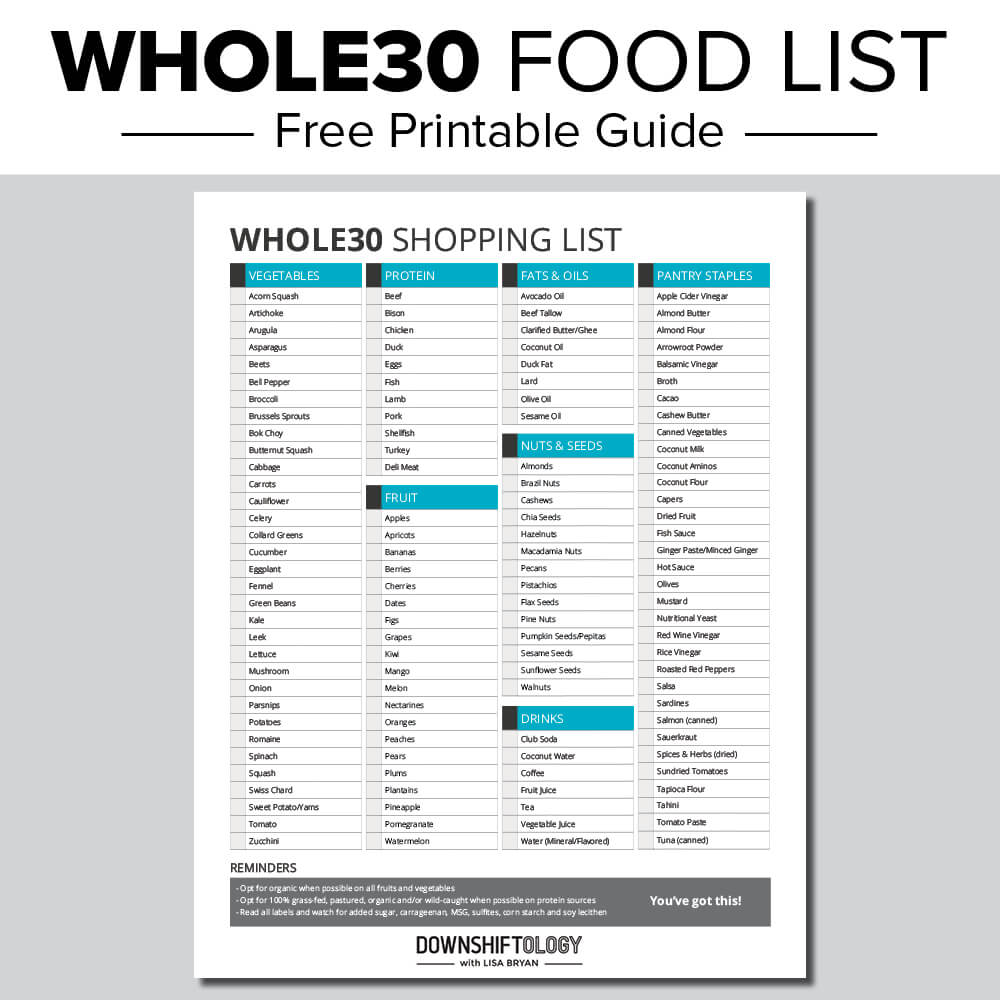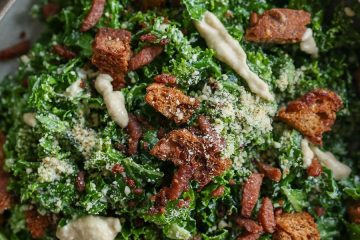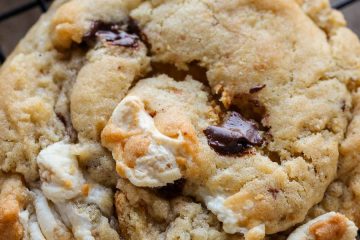Start your Whole30 right by downloading my Whole30 Food list. It’s a shopping list that you can print out and stick on your fridge or bring to the grocery store. I’ve been around the Whole30 block and I’m here to help you navigate the guidelines and what foods to eat and avoid.


Your Whole30 Food List
If you’re anything like me, the new year often feels like a natural moment to make a healthy shift. I’m not talking about low-calorie crash diets or unrealistic weight loss goals, though. I’m talking about hitting the reset button on my eating habits—because, even though I stick to a relatively clean diet most of the time, it’s nearly impossible to avoid all of the sweet holiday treats and festive cocktails. I’m only human, after all.
That’s why I love the Whole30. This 30-day real-food eating plan is one of my favorite ways to essentially recalibrate my taste buds to crave more whole foods, calm inflammation throughout my body, and boost energy levels—things we could all benefit from come January, or after any period of overindulgence.
For me, Whole30 strikes a nice balance of structure and freedom. Yes, there are strict rules about eliminating certain pro-inflammatory food groups and ingredients, but there are still a huge number of foods available to you—and what you can create with these nourishing foods is often truly amazing. For tantalizing food inspiration, check out my favorite Whole30 breakfast recipes, Whole30 lunch ideas, and Whole30 dinner recipes.
But I’ll admit, the first (and even second) Whole30 can be a bit of a learning curve. Even if you know the basics of what to cut out and what to eat, there are many ingredients and additives that fall into somewhat of a gray area—and unless you’re an expert, keeping track of it all can be the most stressful part!
What Exactly is Whole30?
Whole30 is a nutritional program designed to help you eat healthier and eliminate your personal trigger foods—these could be foods that cause an inflammatory or autoimmune response in your body, or simply foods that cause you to lose all self-control.
For 30 days, you will cut out all grains, legumes, soy, dairy, alcohol, added sugars, artificial sweeteners, and processed foods containing any of these ingredients; and load up on all sorts of vegetables, fruits, eggs, quality meats and fish, nuts, seeds, and healthy fats.
The idea is that, after a month, you’ll rid yourself of sugar and carb cravings and start to really notice the positive effects of adopting a whole foods-based diet—whether that’s sleeping better, thinking more clearly, feeling less bloated, or having more of a pep in your step.
After the first 30 days are up, you’re encouraged to slowly reintroduce certain foods one at a time to identify specific items that may be causing unwanted side effects—and thus, what foods you probably want to ditch for good.
Why Should You Do a Whole30?
In a nutshell, because it totally revamps your relationship with food. Whole30 isn’t a diet in the traditional sense. You’re not allowed to weigh yourself, and counting calories and measuring out portions aren’t encouraged either.
The true goal is to eliminate foods that are pro-inflammatory and potential allergens, to recalibrate your taste buds so you naturally crave fewer sweets and carbohydrates, and to break the emotional ties you may have with certain “comfort” foods that have derailed your eating habits (and overall vitality) in the past.
What You Can (and Can’t) Eat on Whole30
First, let’s start off with what you can’t eat. Per the official program rules, you must eliminate all of the following for 30 days, no exceptions:
- Added sugar, real or artificial. This includes (but is not limited to) maple syrup, honey, agave nectar, coconut sugar, date syrup, stevia, monk fruit, Splenda, Equal, Nutrasweet, and xylitol.
- Alcohol. Any form of alcohol is a no go, even for cooking.
- Grains. All grains are off limits (even gluten-free grains!), including wheat, rye, barley, oats, corn, rice, millet, bulgur, sorghum, sprouted grains, quinoa, and buckwheat.
- Legumes. This includes beans of all kinds, peas, chickpeas, lentils, peanuts, and peanut butter. This also includes all forms of soy—soy sauce, miso, tofu, tempeh, edamame, and lecithin.
- Dairy. Milk, cream, cheese, kefir, yogurt, sour cream, ice cream, or frozen yogurt.
- Certain additives. Carrageenan, MSG, and sulfites are all a no go.
- Baked goods, junk foods, or even treats with “approved” ingredients
So, what can you eat? Pretty much anything that’s left over, with a few exceptions. Basically, this includes vegetables, fruits, eggs, quality meats and fish, nuts, seeds, and healthy fats. To make your lives easier, download my Whole30 shopping list for loads of specific compliant foods broken down by food group. And always stock up on Whole30 snacks for grab and go, or make your own Whole30 snack recipes.
You can also watch my What I Eat in a Day video for more Whole30 recipes and inspiration.
5 More Ways to Make Your Whole30 Successful
Beyond simply knowing what to eat and what to skip, here are a few more suggestions for making your Whole30 experience way more enjoyable.
- Prep ahead: First, print out my Whole30 grocery list so you know the ins and outs of the program; then, find some Whole30-approved recipes that you’ll look forward to eating; lastly, set aside a few hours on Sunday to meal prep so you’re less likely to cave to mid-week cravings.
- Remove temptation: Toss any non-compliant foods, or at least keep them out of sight, for the entirety of the program. There’s really something to the old “out of sight, out of mind” saying.
- Think big picture: Whole30 is going to feel impossible if you’re fighting yourself the entire way. So before you begin, make sure this is something you’re truly willing to commit to. One strategy that always helps keep me motivated is jotting down my non-weightloss goals for doing Whole30 (e.g. mental clarity, pain reduction, clearer skin) and what these things will help me do.
- Drink lots of tea: Whenever I find myself itching for a snack and I know I’m not actually hungry, I brew up some herbal or green tea. I personally love a good cup of matcha, which is packed with antioxidants and may help boost cognitive function and aid in weight loss.
- Do it with a friend: Don’t underestimate the power of an accountability partner! There will be moments during your Whole30 that are really tough, so having someone to commiserate with can honestly be pretty helpful. Sharing words of encouragement and tasty recipes is great too.





